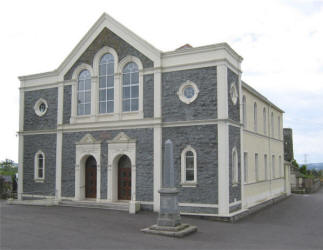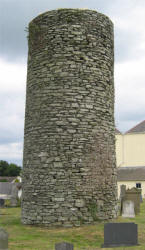
Drumbo Presbyterian Church
 |
 |
| Drumbo Presbyterian Church, built in 1882. | The round tower at Drumbo Presbyterian Church |
|
|
_small.jpg) |
|
Rev. Adrian McLernon
Minister |
Rev. Kenneth Smyth
Minister Emeritus |
In the centre of the village of Drumbo.
Minister: Rev. Adrian McLernon
Telephone: 9082 6373
Minister Emeritus: Rev. Kenneth Smyth
Sunday services:
Morning: 11.30am.
Evening: 6.30pm.
Presbyterian Church in Ireland Website: www.presbyterianireland.org
_small.jpg) |
HISTORY – The Church
The earliest mention of this congregation comes in 1655 when we find Mr. Henry Livingstone ordained here. He was a nephew of the famous John Livingstone of Killinchy. He continued in this charge till 7th April 1697 when he died, aged 66 years. His successor was Mr. Edward T. Bailly who appears to have been ordained here on 16th June 1699, although the tablet in the church indicates 1697 as the year. His death occurred on 27th June 1703, although his tombstone again differs by placing it on 26th June 1703. The next minister was Mr. Thomas Gowan (lic. Antrim), son of the renowed Latinist and founder of the School of Philosophy and Divinity at Antrim. He was ordained here on 29th March 1706. In 1716 he had a unanimous call from the English Presbyterian Church at Leyden, Holland, which the Synod permitted him to accept. He was succeeded by Mr. Patrick Bruce, son of Rev. James Bruce of Killyleagh and brother of Rev. Michael Bruce of Holywood. Mr. Patrick Bruce was ordained here on 12th June 1717. Towards the close of the year 1729 he resigned this charge and removed to Scotland, where he became minister of Kilellan, in the Presbytery of Paisley. He subsequently returned to Killyleagh.
In 1729 Drumbo came under the care of the Presbytery of Bangor and in 1730 sought supplies of probationers. Their next minister was Mr. Andrew Malcolm (lic. Bangor) who was ordained on 27th November 1731. He died in this charge on 2nd March 1763. He was succeeded by his nephew Mr. James Malcolm who was ordained here on 24th December 1764. In 1775 it was reported to the Synod that owing to severe mental infirmity Mr. Malcolm had not been able to officiate for two years. Their request to be declared vacant was granted.
Their next minister was Mr. Hugh McKee (lic. Belfast) ordained here by the Presbytery of Belfast on 25th September 1776. He demitted the charge in June 1781. In 1792, Mr. Malcolm having recovered, the people applied for his restoration to the ministry among them. The Synod appointed a committee to judge the case. They installed him in his charge towards the close of the same year; and the Synod approved of this proceeding. In May 1794, in consequence of indisposition and infirmity, Mr. Malcolm was again obliged to resign the pastoral charge. The next minister was Mr. Samuel Hanna (lic. Ballymena). He was ordained here on 4th August 1795 and after four years resigned in 1799 on receiving a call to Rosemary Street, Belfast. He later became the first Moderator of the General Assembly in 1840. He was succeeded by Mr. James Riddle, or Riddel (lic. Dromore) who was ordained on 3 Sept. 1800. Mr. Malcolm died on 3rd October 1805 and Mr. Riddle, after being suspended for twelve months in 1825, was suspended sine die in 1826.
The next minister was Mr. Campbell Blakely (lic. Belfast) who was ordained by the Presbytery of Belfast on 24th July 1827. His predecessor, Mr. Riddle died soon afterwards on 25th February 1828, and Mr. Blakely was the subject of much controversy in the congregation (S. of U. Min. 1828). There were moves to have him disannexed but the Synod thought it best that he should stay. They removed him from the Presbytery of Belfast into the Presbytery of Bangor. When Mr. Blakely became infirm after 40 years, Mr. James McNeill (lic. Ballymena) became his assistant and successor on 7th May 1867. When he had been eleven years in Drumbo he received a call from First Lurgan, which he accepted. He took ill and then asked leave to withdraw, and he was installed again in Drumbo. Mr. Blakely died on 1st December 1872 and Mr. McNeill on 18th February 1890 in his forty-ninth year.
The tenth minister called was Rev. William James Warnock of Stewartstown. He was installed here on 14th May 1891 but had to resign for health reasons in 1899. He went to live in South Africa where he died aged 37 years on 28th November 1900. Mr. William McNeill, a son of the Rev. James McNeill (above) was then called and ordained on 16th November 1899. He resigned when called to Adelaide Road, Dublin, on 11th November 1903, and was followed by Mr. James Irwin (lic. Newry) who was ordained on 5th April 1904. He stayed until 31stMarch 1911 when he responded to a call to St. Aidan’s U.F. Church, Melrose, Scotland.
Mr. Joseph Cordner (lic. Dromore), a Lurgan man, was next ordained on 2nd August 1911, and he exercised a memorable ministry until he resigned after fifteen years on a call to Hamilton Road Church, London, Ontario, Canada, on 17th September 1926. His successor was Mr. John Barkley Wallace (lic. Ballymena) who was ordained on 29th December 1926, retired on 1stFebruary 1963 and died on 28th December 1963. Mr. Wallace wrote a history of the congregation.
The Rev. Kenneth Smyth of Glastry was installed on 3rd September 1963, the fifteenth Presbyterian minister on this historic site. He had extensions made to the school hall (1960) and to the church itself (1979). Mr. Smyth retired in 1993 and is now the Minister Emeritus of Drumbo. His successor, the Rev. Hugh Mullan, previously in Castledawson and Curran was installed here on 23rd September 1993 and in early 2003 he accepted a call to Drumreagh and Dromore.
The present minister, the Rev. Adrian McLernon, previously in Castlecaulfield and Eglish, was installed in Drumbo in February 2003.
To see a book entitled ‘Drumbo Presbyterian Church - A Short History (1655-1956)’ written by the Rev. J. B. Wallace M. A., click on Drumbo Presbyterian Church - A Short History (1655-1956)
HISTORY – The Round Tower
The Round Tower is the only remaining one in County Down. This fact greatly adds to its interest. There are many of them in Ireland, and the theories as to their origin and use are very numerous. Some writers have attributed them to the Danes, while others have declared them to be of Phoenician origin. In respect of their uses, the following are some of the theories: used as places from which to proclaim the Druidical festivals; fire-temples; gnomons or astronomical observatories; phallic emblems or Buddhist temples; anchorite towers or stylite columns; penitential prisons, belfries, keeps or monastic castles, beacons, and watch-towers.
This brief history of the round tower is taken from a book entitled ‘Drumbo Presbyterian Church - A Short History (1655-1956)’ written by the Rev. J. B. Wallace M. A.
Brief history as recorded in a book ‘Lisburn’s Rich Church Heritage’ by John Kelly
The earliest mention of this congregation comes in 1655 when we find Mr Henry Livingstone ordained here. In 1729 Drumbo came under the care of the Presbytery of Bangor and in 1730 sought supplies of probationers. During the ministry of the Rev Andrew Malcolm the church was either rebuilt, or the first one renovated and enlarged. The old National School was built in 1836, and during Mr William Warnock’s ministry a new schoolroom was erected. The present church was built in 1882 during the ministry of the Rev James McNeill. The Rev Kenneth Smyth was installed in 1963, and made extensions to the school hall in 1969 and 1989, and to the church in 1979. Mr Smyth retired in 1993 and is now the Minister Emeritus. The present minister, the Rev Adrian McLernon, was installed in February 2003.
